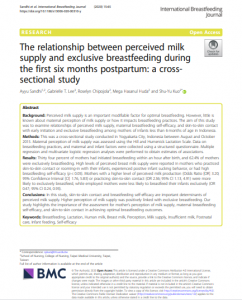
Background
Perceived milk supply is an important modifiable factor for optimal breastfeeding. However, little is known about maternal perception of milk supply or how it impacts breastfeeding practices. The aim of this study was to examine relationships of perceived milk supply, maternal breastfeeding self-efficacy, and skin-to-skin contact with early initiation and exclusive breastfeeding among mothers of infants less than 6 months of age in Indonesia.
Methods
This was a cross-sectional study conducted in Yogyakarta City, Indonesia between August and October 2015. Maternal perception of milk supply was assessed using the Hill and Humenick Lactation Scale. Data on breastfeeding practices, and maternal and infant factors were collected using a structured questionnaire. Multiple regression and multivariate logistic regression analyses were performed to obtain estimates of associations.
Results
Thirty four percent of mothers had initiated breastfeeding within an hour after birth, and 62.4% of mothers were exclusively breastfeeding. High levels of perceived breast milk supply were reported in mothers who practiced skin-to-skin contact or rooming-in with their infants, experienced positive infant sucking behavior, or had high breastfeeding self-efficacy (p < 0.05). Mothers with a higher level of perceived milk production (Odds Ratio [OR] 3.20; 95% Confidence Interval [CI] 1.76, 5.83) or practicing skin-to-skin contact (OR 2.36; 95% CI 1.13, 4.91) were more likely to exclusively breastfeed, while employed mothers were less likely to breastfeed their infants exclusively (OR 0.47; 95% CI 0.24, 0.93).